928 scholarly books by The Ohio State University Press and 15
have author last names that start with N
928 scholarly books by The Ohio State University Press and 15
928 scholarly books by The Ohio State University Press
15 have author last names that start with N have author last names that start with N
15 have author last names that start with N have author last names that start with N

Poetics of Visibility in the Contemporary Arab American Novel
Mazen Naous
The Ohio State University Press, 2020
How might art disrupt Arabophobia and Islamophobia in the US? In Poetics of Visibility in the Contemporary Arab American Novel, Mazen Naous argues that fiction is one of the ways in which Arab Americans can correct dominant narratives of themselves with representation of their lived realities. Looking at both the aesthetics and politics in contemporary Arab American novels, Naous demonstrates that the novels’ poetics cannot be extricated from or subsumed under political content. In his finely textured analyses of form and style, Naous uncovers crucial transcultural and transpoetic solidarities that extend beyond the politics of representation.
Naous’s book offers analyses of Diana Abu-Jaber’s Arabian Jazz and Crescent, Rabih Alameddine’s Koolaids: The Art of War, Laila Halaby’s Once in a Promised Land, and Mohja Kahf’s The Girl in the Tangerine Scarf as ways to answer this question. Naous explores how these novels negotiate queer desire, music, Western and Middle Eastern art, gender, and relationships between other minorities. These poetics enable readers to see the nuance and richness of Arab American experience. Naous ultimately argues that fiction creates crucial spaces for reimagining and redefining intercultural relationships.
Naous’s book offers analyses of Diana Abu-Jaber’s Arabian Jazz and Crescent, Rabih Alameddine’s Koolaids: The Art of War, Laila Halaby’s Once in a Promised Land, and Mohja Kahf’s The Girl in the Tangerine Scarf as ways to answer this question. Naous explores how these novels negotiate queer desire, music, Western and Middle Eastern art, gender, and relationships between other minorities. These poetics enable readers to see the nuance and richness of Arab American experience. Naous ultimately argues that fiction creates crucial spaces for reimagining and redefining intercultural relationships.
[more]
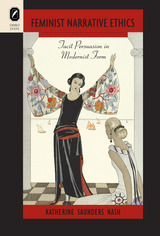
Feminist Narrative Ethics
Tacit Persuasion in Modernist Form
Katherine Saunders Nash
The Ohio State University Press, 2014
Feminist Narrative Ethics: Tacit Persuasion in Modernist Form establishes a new theory of narrative ethics by analyzing rhetorical techniques prompt readers of novels to reconsider their ethical convictions about women’s rights. Katherine Saunders Nash proposes four new theoretical paradigms: the ethics of persuasion (Virginia Woolf), of fair play (Dorothy L. Sayers), of distance (E. M. Forster), and of attention (John Cowper Powys). While offering close readings of novels by each author, this book also provides a new, interdisciplinary basis for coordinating feminist and rhetorical theories, history, and narrative technique.
Despite pronouncements by many theorists about the difficulty—even the impossibility—of doing justice in a single study to both history and form, Feminist Narrative Ethics proves that they can be mutually illuminating. Its approach is not only resolutely rhetorical, but resolutely historical as well. It strikes a felicitous balance between history and form that affords new understanding of the implied author concept.
Feminist Narrative Ethics makes a persuasive case for the necessity of locating authorial agency in the implied (rather than the actual) author and cogently explains why rhetorical theory insists on the concept of an implied (rather than an inferred) author. And it proposes a new facet of agency that rhetorical theorists have heretofore neglected: the ethics of progressive revisions to a project in manuscript.
Despite pronouncements by many theorists about the difficulty—even the impossibility—of doing justice in a single study to both history and form, Feminist Narrative Ethics proves that they can be mutually illuminating. Its approach is not only resolutely rhetorical, but resolutely historical as well. It strikes a felicitous balance between history and form that affords new understanding of the implied author concept.
Feminist Narrative Ethics makes a persuasive case for the necessity of locating authorial agency in the implied (rather than the actual) author and cogently explains why rhetorical theory insists on the concept of an implied (rather than an inferred) author. And it proposes a new facet of agency that rhetorical theorists have heretofore neglected: the ethics of progressive revisions to a project in manuscript.
[more]
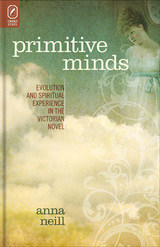
Primitive Minds
Evolution and Spiritual Experience in the Victorian Novel
Anna Neill
The Ohio State University Press, 2013
For twenty-first-century veterans of the evolution culture wars, Primitive Minds: Evolution and Spiritual Experience in the Victorian Novel, by Anna Neill, makes unlikely bedfellows of two Victorian “discoveries”: evolutionary theory and spiritualism. Victorian science did much to uncover the physical substratum of mystical or dreamy experience, tracing spiritual states to a lower, reflex, or more evolutionarily primitive stage of consciousness. Yet science’s pursuit of knowledge beyond sense-based evidence uncannily evoked powers associated with this primitive mind: the capacity to link events across space and time, to anticipate the future, to uncover elements of the forgotten past, and to see into the minds of others.
Neill does not ask how the Victorians explained away spiritual experience through physiological psychology, but instead explores how physical explanation interacted with dreamy content in Victorian accounts of the mind’s most exotic productions. This synthesis, she argues, was particularly acute in realist fiction, where, despite novelists’ willingness to trace the nervous origins of individual behavior and its social consequences, activity in hidden regions of the mind enabled levels of perception inaccessible to ordinary waking thought. The authors in her study include Charlotte Brontë, Charles Dickens, George Eliot, Arthur Conan Doyle, and Thomas Hardy.
[more]
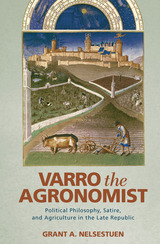
Varro the Agronomist
Political Philosophy, Satire, and Agriculture in the Late Republic
Grant A. Nelsestuen
The Ohio State University Press, 2015
Some six years after his narrow escape from proscription in 43 bce, Marcus Terentius Varro, the “most learned” of the Romans, wrote a technical treatise on farming in the form of a satirico-philosophical dialogue. Grant A. Nelsestuen argues that far from simply being just another encyclopedic entry of a seemingly aloof antiquarian or offering an escapist’s retreat into rustication, Varro’s De Re Rustica uses the model of the farm to craft an implicitly political treatise that grapples with multifarious challenges facing the contemporary Roman world.
On one level, Varro’s treatise presents an innovative account of the Roman farm, which rationalizes new agricultural and pastoral opportunities for contemporary elite owners of large-scale estates. But on another level, this bold agronomical vision associates the farm’s different spheres with distinct areas under Roman control, thereby allegorizing Rome’s empire on the model of a farm. Nelsestuen argues that Varro’s treatise thus provides his contemporaries with a model for governing the Roman state, anticipates Augustus’ subsequent transformation of Roman dominion into a coherent territorial state, and offers an ancient theory of imperialism.
Shedding new light on the only completely extant work of a much-celebrated but ill-understood figure, Varro the Agronomist has much to offer to those interested in Latin literature—especially, Cicero and Vergil—as well as on the political dimensions of intellectual life in first-century bce Rome, ancient imperialism, and Roman political philosophy.
On one level, Varro’s treatise presents an innovative account of the Roman farm, which rationalizes new agricultural and pastoral opportunities for contemporary elite owners of large-scale estates. But on another level, this bold agronomical vision associates the farm’s different spheres with distinct areas under Roman control, thereby allegorizing Rome’s empire on the model of a farm. Nelsestuen argues that Varro’s treatise thus provides his contemporaries with a model for governing the Roman state, anticipates Augustus’ subsequent transformation of Roman dominion into a coherent territorial state, and offers an ancient theory of imperialism.
Shedding new light on the only completely extant work of a much-celebrated but ill-understood figure, Varro the Agronomist has much to offer to those interested in Latin literature—especially, Cicero and Vergil—as well as on the political dimensions of intellectual life in first-century bce Rome, ancient imperialism, and Roman political philosophy.
[more]

Immanence and Transcendance
The Theater of Jean Rotrou (1609-1650)
Robert J. Nelson
The Ohio State University Press, 1900
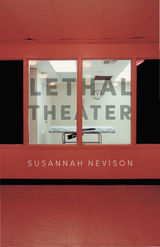
Lethal Theater
Susannah Nevison
The Ohio State University Press, 2019
In her new poetry collection, Lethal Theater, Susannah Nevison reckons with the rituals of violence that underpin the American prison system, both domestically and abroad. Exploring the multiple roles of medicine in incarceration, Nevison’s poems expose the psychological and physical pain felt by the prison system’s inhabitants. Nevison asks readers to consider the act and complications of looking—at the spectacle of punishment, isolation, and interrogation, as mapped onto incarcerated bodies—by those who participate in and enforce dangerous prison practices, those who benefit from the exploitation of incarcerated bodies, and those who bear witness to suffering. Unfolding in three sections, Nevison’s poems fluidly move among themes of isolation and violence in prisons during period of war, the history of medical experimentation on domestic prisoners, and the intersection between anesthesia used in hospital settings and anesthesia used in cases of lethal injection. Lethal Theater is an attempt to articulate and make visible a grotesque and overlooked part of American pain.
[more]
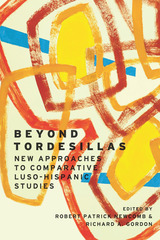
Beyond Tordesillas
New Approaches to Comparative Luso-Hispanic Studies
Robert Patrick Newcomb
The Ohio State University Press, 2017
Beyond Tordesillas: New Approaches to Comparative Luso-Hispanic Studies is the first volume of its kind to be published in English. Bringing together young and established scholars, it seeks to consolidate the vital work being done on the connections between the Spanish- and Portuguese-speaking worlds on both sides of the Atlantic. The volume builds from an understanding that Iberian and Latin American cultures are inherently transoceanic—having engaged in earlier eras in parallel, and sometimes interconnected, colonization projects around the world and more recently in postcolonial evaluations of these practices and their legacies.
The jumping-off point for Beyond Tordesillas is the critic Jorge Schwartz’s evocative call to arms, “Down with Tordesillas!” In this groundbreaking essay, Schwartz looks to the imaginary line created by the Treaty of Tordesillas (1494), which divided the known world into Spanish and Portuguese spheres of influence, to stand in for generations of literary and cultural noncommunication between the Spanish- and Portuguese-speaking spheres, and their attendant academic disciplines. This volume’s contributions range topically across continents, from the Iberian Peninsula to Latin American countries. They also range across genres, with studies that analyze fictional narrative, music, performance, and visual culture. Beyond Tordesillas forcefully challenges the disciplinary—and indeed, arbitrary—boundaries that for too long have separated Hispanic and Luso-Brazilian studies.
The jumping-off point for Beyond Tordesillas is the critic Jorge Schwartz’s evocative call to arms, “Down with Tordesillas!” In this groundbreaking essay, Schwartz looks to the imaginary line created by the Treaty of Tordesillas (1494), which divided the known world into Spanish and Portuguese spheres of influence, to stand in for generations of literary and cultural noncommunication between the Spanish- and Portuguese-speaking spheres, and their attendant academic disciplines. This volume’s contributions range topically across continents, from the Iberian Peninsula to Latin American countries. They also range across genres, with studies that analyze fictional narrative, music, performance, and visual culture. Beyond Tordesillas forcefully challenges the disciplinary—and indeed, arbitrary—boundaries that for too long have separated Hispanic and Luso-Brazilian studies.
[more]

WHEN KIDS GO TO COLLEGE
A PARENTS GUIDE TO CHANGING RELATIONSHIP
BARBARA & PHILIP R. NEWMAN & NEWMAN
The Ohio State University Press, 1992
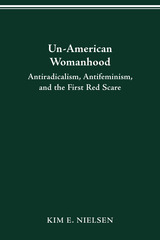
UN-AMERICAN WOMAN
ANTI-RACISM, ANTI-FEMINISM, AND THE FIRST RED SCARE
KIM NIELSEN
The Ohio State University Press, 2001
Un-American Womanhood studies the Red Scare of the 1920s through the lens of gender. Kim Nielsen describes the methods antifeminists used to subdue feminism and other movements they viewed as radical. By tapping into widespread anxieties about Bolshevism and the expansion of the state, antifeminist women fought against certain social welfare programs such as the Sheppard-Towner Act and the Children’s Bureau and resisted efforts to legitimize the female citizen as an autonomous political figure. The book also considers the seeming contradictions of outspoken antifeminists who broke with traditional gender norms to assume forceful and public roles in their efforts to denounce feminism.
[more]
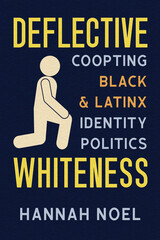
Deflective Whiteness
Co-Opting Black and Latinx Identity Politics
Hannah Noel
The Ohio State University Press, 2022
In Deflective Whiteness, Hannah Noel repositions Whiteness studies in relation to current discussions around racialized animus and White victimhood, demonstrating how White supremacy adapts its discursive strategies by cannibalizing the language and rhetoric of Black and Latinx social justice movements. Analyzing a wide-ranging collection of cultural objects—memes, oration, music, advertisements, and news coverage—Noel shows how White deflection sustains and reproduces structures of inequality and injustice.
White deflection offers a script for how social justice rhetoric and the emotions of victimization are appropriated to conjure a hegemonic White identity. Using derivative language, deflection claims Whiteness as the aggrieved social status. Through case studies of cultural moments and archives including Twitter, country music, the Black Lives Matter movement, and more, Deflective Whiteness exposes the various forms of tacit White supremacy that operate under the alibi of injury and that ultimately serve to deepen racial inequities. By understanding how, where, and why White deflection is used, Noel argues, scholars and social justice advocates can trace, tag, and deconstruct covert White supremacy at its rhetorical foundations.
White deflection offers a script for how social justice rhetoric and the emotions of victimization are appropriated to conjure a hegemonic White identity. Using derivative language, deflection claims Whiteness as the aggrieved social status. Through case studies of cultural moments and archives including Twitter, country music, the Black Lives Matter movement, and more, Deflective Whiteness exposes the various forms of tacit White supremacy that operate under the alibi of injury and that ultimately serve to deepen racial inequities. By understanding how, where, and why White deflection is used, Noel argues, scholars and social justice advocates can trace, tag, and deconstruct covert White supremacy at its rhetorical foundations.
[more]
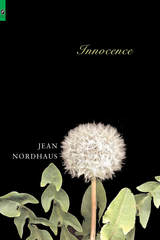
INNOCENCE
JEAN NORDHAUS
The Ohio State University Press, 2006
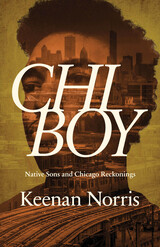
Chi Boy
Native Sons and Chicago Reckonings
Keenan Norris
The Ohio State University Press, 2022
In Chi Boy, Keenan Norris melds memoir, cultural criticism, and literary biography to indelibly depict Chicago—from the Great Migration to the present day—as both a cradle of black intellect, art, and politics and a distillation of America’s deepest tragedies. With the life and work of Richard Wright as his throughline, Norris braids the story of his family and particularly of his father, Butch Norris, with those of other black men—Wright, Barack Obama, Ralph Ellison, Frank Marshall Davis—who have called Chicago home. Along the way he examines the rise of black street organizations and the murders of Yummy Sandifer and Hadiya Pendleton to examine the city’s status in the cultural imaginary as “Chi-Raq,” a war zone within the nation itself. In Norris’s telling, the specter of violence over black life is inescapable: in the South that Wright and Butch Norris escaped, in the North where it finds new forms, and worldwide where American militarism abroad echoes brutalities at home. Yet, in the family story at the center of this unforgettable book, Norris also presents an enduring vision of hope and love.
[more]
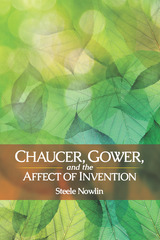
Chaucer, Gower, and the Affect of Invention
Steele Nowlin
The Ohio State University Press, 2016
In this book, Steele Nowlin examines the process of poetic invention as it is conceptualized and expressed in the poetry of Geoffrey Chaucer (1343–1400) and John Gower (ca. 1330–1408). Specifically, it examines how these two poets present invention as an affective force, a process characterized by emergence and potentiality, and one that has a corollary in affect—that is, a kind of force or sensation distinct from emotion, characterized as an “intensity” that precedes what is only later cognitively understood and expressed as feeling or emotion, and that is typically described in a critical vocabulary of movement, emergence, and becoming.
Chaucer, Gower, and the Affect of Invention thus formulates a definition of affect that differs from most work in the recent “turn to affect” in medieval studies, focusing not on the representation of emotion or desire, or efforts to engage medieval alterity, but on the movement and emergence that precede emotional experience. It likewise argues for a broader understanding of invention in late medieval literature beyond analyses of rhetorical poetics and authorial politics by recuperating the dynamism and sense of potential that characterize inventional activity. Finally, its close readings of Chaucer’s and Gower’s poetry provide new insights into how these poets represent invention in order to engage the pervasive social and cultural discourses their poetry addresses.
Chaucer, Gower, and the Affect of Invention thus formulates a definition of affect that differs from most work in the recent “turn to affect” in medieval studies, focusing not on the representation of emotion or desire, or efforts to engage medieval alterity, but on the movement and emergence that precede emotional experience. It likewise argues for a broader understanding of invention in late medieval literature beyond analyses of rhetorical poetics and authorial politics by recuperating the dynamism and sense of potential that characterize inventional activity. Finally, its close readings of Chaucer’s and Gower’s poetry provide new insights into how these poets represent invention in order to engage the pervasive social and cultural discourses their poetry addresses.
[more]

Brief Interviews with the Romantic Past
Kathryn Nuernberger
The Ohio State University Press, 2017
Could Marie Antoinette’s wigs get any higher? Could the anonymous women riding in hot air balloons alone with gentlemen be any more scandalous? Does an Ozark holler hold the mouth to a lost cave with the longest, thickest vein of gold in North America? Brief Interviews with the Romantic Past is a collection of rumors, secrets, tall tales, and lies that begins at the court of Louis XV and ends in the foothills of the Ozark Mountains.
With all the astonishments of history and the intimacy of memoir, Kathryn Nuernberger’s collection juxtaposes peripheral figures from the French Revolution—the assassin, the executioner, the mistress, the spy, the son of a slave, the transgender swordfighter—with the oral histories of poachers, prophets, well witches, and ghosts of the Ozarks a century later. In essays that are equal parts historical and personal, Nuernberger brings the marvelous strangeness of the past into our present moment with wry wit and insight. Nuernberger has an eye for salvaging overlooked snapshots of human decency and moments of moral courage—the memories of which we might just want to save for later.
With all the astonishments of history and the intimacy of memoir, Kathryn Nuernberger’s collection juxtaposes peripheral figures from the French Revolution—the assassin, the executioner, the mistress, the spy, the son of a slave, the transgender swordfighter—with the oral histories of poachers, prophets, well witches, and ghosts of the Ozarks a century later. In essays that are equal parts historical and personal, Nuernberger brings the marvelous strangeness of the past into our present moment with wry wit and insight. Nuernberger has an eye for salvaging overlooked snapshots of human decency and moments of moral courage—the memories of which we might just want to save for later.
[more]
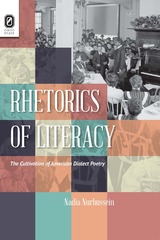
Rhetorics of Literacy
The Cultivation of American Dialect Poetry
Nadia Nurhussein
The Ohio State University Press, 2013
Rhetorics of Literacy: The Cultivation of American Dialect Poetry explores the production and reception of dialect poetry in late nineteenth- and early twentieth-century America and investigates the genre’s rhetorical interest in where sound meets print. Dialect poetry’s popularity stems not only from its use as an entertaining distraction from “serious” poetry, but as a surprisingly complicated pedagogical tool collaborating with elite literary culture. Indeed, the intersections of the oral and textual aspects of the dialect poem, visible in both its composition and its reception, resulted in confusing and contradictory interactions with the genre.
In this innovative study, Nadia Nurhussein demonstrates how an art form that appears to be most closely linked to the vernacular is in fact preoccupied with investigating its distance from it. Although dialect poetry performance during this period has garnered more attention than the silent reading of it, the history of dialect poetry’s reception proves that readers invited the challenge of printed dialect into their lives in unexpected places, such as highbrow magazines and primary school textbooks. Attentiveness to the appearances of dialect poetry in print—in books, pamphlets, magazines, newspapers, and other media—alongside its recitation are necessary to an understanding of its cultural impact.
Recontextualizing familiar and neglected poets, Rhetorics of Literacy proposes new literary genealogies and throws light upon the cultural and literary relevance of the laborious and strange reading practices associated with dialect poetry that made it distinct from other popular literary genres.
[more]
READERS
Browse our collection.
PUBLISHERS
See BiblioVault's publisher services.
STUDENT SERVICES
Files for college accessibility offices.
UChicago Accessibility Resources
home | accessibility | search | about | contact us
BiblioVault ® 2001 - 2024
The University of Chicago Press









